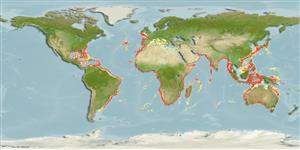Elasmobranchii (haaien en roggen) (sharks and rays) >
Squaliformes (Bramble, sleeper and dogfish sharks) >
Centrophoridae (Gulper sharks)
Etymology: Centrophorus: Greek, kentron = sting + Greek, pherein = to carry (Ref. 45335).
Omgeving / Klimaat / Range
Ecologie
; marien bathydemersaal; diepteverspreiding 50 - 1440 m (Ref. 247), usually 200 - 600 m (Ref. 247). Deep-water, preferred 24°C (Ref. 107945); 51°N - 43°S, 98°W - 156°E
Eastern Atlantic: France to South Africa, including the Mediterranean (Ref. 31367). Western Central Atlantic: northern Gulf of Mexico (Ref. 247, 6871). Indian Ocean: Mozambique, South Africa and the Aldabra Islands (Ref. 31367); Western Australia (Ref. 6871). Western Pacific: Japan, Papua New Guinea, and Australia (Ref. 31367). Not in the Eastern Pacific (Ref. 94782).
Length at first maturity / Size / Gewicht / Leeftijd
Maturity: Lm ?, range 105 - 118 cm
Max length : 170 cm TL mannelijk/geslacht niet bekend; (Ref. 94782); 145.5 cm TL (female)
Dorsale stekels (totaal): 2; Dorsale zachte stralen (totaal): 0; Anale stekels 0; Anale zachte stralen: 0. Light grayish brown dorsally, paler ventrally; eyes greenish (Ref. 6871). Adults with tips of dorsal fins dusky, not prominently marked (Ref. 31367).
A common deepwater dogfish of the outer continental shelves and upper slopes, commonest below 200 m (Ref. 247); usually benthic and epibenthic at depths from 50-1440 m with most records from 200-600 m (Compagno, pers. comm. 07/07). Solitary (Ref. 26340). Adults feed mainly on bony fishes such as hake, epigonids, lanternfish, herring, smelts, cods, rattails, squid and crustaceans (Ref. 247, IUCN workshop 07/07). Males mature at about 105-118 cm TL (Ref. 94782). Ovoviviparous (Ref. 50449). Number of litter recorded, one in Mediterranean females, and possibly 1 or 2 for the species. This species is fished in Eastern Atlantic by bottom trawls, long lines, fixed bottom nets, hook and line and pelagic trawls; caught and discarded, or utilised from by-catch fisheries (IUCN discussion 07/07). Marketed smoked and dried salted for human consumption; also processed into fishmeal and a source of liver oil for squalene (Ref. 247).
Ovoviviparous, embryos feed solely on yolk (Ref. 50449). Young are born from 30 to 42 cm or more (Ref. 247). Distinct pairing with embrace (Ref. 205).
Compagno, L.J.V., 1984. FAO Species Catalogue. Vol. 4. Sharks of the world. An annotated and illustrated catalogue of shark species known to date. Part 1 - Hexanchiformes to Lamniformes. FAO Fish. Synop. 125(4/1):1-249. Rome, FAO. (Ref. 247)
Status op de Rode Lijst van het IUCN (Ref. 115185)
CITES (Ref. 94142)
Not Evaluated
Gevaarlijk voor mensen
Harmless
Gebruik door de mens
Visserij: van minder commercieel belang
Meer informatie
ReferentiesAquacultuurAquacultuurprofielKweeklijnenGeneticaAlleelfrequentiesErfelijkheidZiektenVerwerkingMass conversion
Tools
Speciale rapporten
Download XML
Internet-bronnen
Estimates of some properties based on models
Phylogenetic diversity index (Ref.
82805): PD
50 = 0.5003 [Uniqueness, from 0.5 = low to 2.0 = high].
Bayesian length-weight: a=0.00251 (0.00154 - 0.00411), b=3.17 (3.03 - 3.31), in cm Total Length, based on LWR estimates for this species & (Sub)family-body (Ref.
93245).
Trophic Level (Ref.
69278): 4.1 ±0.4 se; Based on diet studies.
Weerstandsvermogen (Ref.
69278): laag, minimale populatieverdubbelingstijd 4,5-14 jaar (Fec assumed to be <100).
Kwetsbaarheid (Ref.
59153): Very high vulnerability (87 of 100) .
